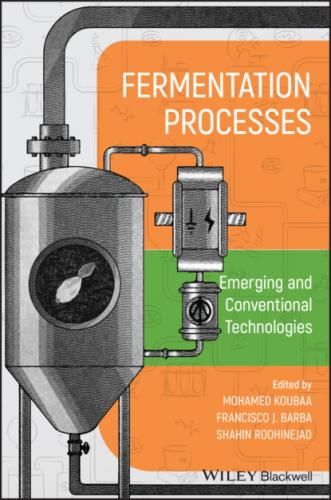An optimal production system could be achieved by taking a few requirements that include:
1 Avoiding the contamination of the culture, which can be achieved by designing a bioreactor where the inputs and outputs of the fermenter are controlled;
2 No leakage or water evaporation from the medium can occur;
3 Agitation of the medium should be perfect to allow a homogenous distribution of O2 in the medium and the maintenance of O2 concentration above the critical value; and
4 The fermentation parameters that include the pH, temperature, etc. must be automatically controlled.
A successful process occurs when all the parameters required for the growth and production of a molecule of interest are brought together. Yield and productivity constitute the two main aspects to be quantified during fermentation. They indicate the conversion efficiency of the substrate into cells and products. The following equations are given for culture in batch mode.
The yield in biomass YX/S is given by Eq. (1.3) and corresponds to the mass (g) of dry cell biomass produced per gram of substrate consumed (g g−1).
where X0 and X correspond, respectively, to the initial and final biomass concentrations (g l−1). S0 and S correspond, respectively, to the initial and final carbon substrate concentrations (g l−1).
The yield in product YP/S is given by Eq. (1.4) and corresponds to the weight in grams of product produced per gram of substrate consumed (g g−1).
where P0 and P correspond, respectively, to the initial and final product concentrations (g l−1). S0 and S correspond, respectively, to the initial and final carbon substrate concentrations (g l−1).
The productivity in biomass PX is given by Eq. (1.5) and corresponds to the weight in grams of biomass produced per liter of culture per hour (g l−1 h−1).
where X0 and Xt correspond, respectively, to the initial biomass concentration and that at time t (g l−1). t0 and t correspond, respectively, to the initial and final time (h).
The productivity in product Pp is given by Eq. (1.6) and corresponds to the weight in grams of product produced per liter of culture per hour (g l−1 h−1).
where P0 and Pt correspond, respectively, to the initial product concentration and that at time t (g l−1). t0 and t correspond, respectively, to the initial and final time (h).
1.5 Conclusions
This chapter summarized the different steps to conduct a conventional fermentation with a special emphasis on energy metabolism, the different microorganisms used at industrial scale, as well as process parameters and performances. Nonetheless, the field of bioprocesses includes as well the culture of plant and animal cells, algae, and environmental processes. After fermentation, depending on the intracellular or extracellular localization of the synthesized product, cell lysis is required before starting the different downstream processing steps. Fermentation optimization could be performed using different approaches such as the use of the design of experiment approach and the implementation of emerging technologies to assist the fermentation.
References
1 Actis, L.A., Tolmasky, M.E., and Crosa, J.H. (1999). Bacterial plasmids: replication of extrachromosomal genetic elements encoding resistance to antimicrobial compounds. Front. Biosci. (4): D43–D62.
2 Angelidaki, I., Karakashev, D., Batstone, D.J. et al. (2011). Biomethanation and its potential. In: Methods in Enzymology, Methods in Methane Metabolism, Part A (eds. A.C. Rosenzweig and S.W. Ragsdale), 327–351. Academic Press.
3 Bérdy, J. (2005). Bioactive microbial metabolites. J. Antibiot. (Tokyo) 58: 1–26.
4 Campbell, M.K. (2015). Biochemistry. Belmont, CA: Cengage Learning Brooks/Cole. ed.
5 Cao, H., Chen, X., Jassbi, A.R., and Xiao, J. (2015). Microbial biotransformation of bioactive flavonoids. Biotechnol. Adv. 33: 214–223.
6 Carnes, A.E. and Williams, J.A. (2014). Plasmid fermentation process for DNA immunization applications. In: DNA Vaccines: Methods and Protocols, Methods in Molecular Biology (eds. M. Rinaldi, D. Fioretti and S. Iurescia), 197–217. New York, NY: Springer New York.
7 Carnes, A.E., Hodgson, C.P., and Williams, J.A. (2006). Inducible Escherichia coli fermentation for increased plasmid DNA production. Biotechnol. Appl. Biochem. 45: 155–166.
8 Charles, M. (1999). Fermenter design. In: Encyclopedia of Bioprocess Technology: Fermentation, Biocatalysis, and Bioseparation (eds. M.C. Flickinger and S.W. Drew), 1157–1189. New York / Chichester / Weinheim / Brisbane / Singapore / Toronto: Wiley.
9 Cooper, G.M. (2000). The Cell: A Molecular Approach. Washington, D.C.: ASM Press; Sinauer Associates.
10 de Souza, P.M. and de Oliveira Magalhães, P. (2010). Application of microbial α‐amylase in industry – a review. Braz. J. Microbiol. 41: 850–861.
11 Defavari do Nascimento, D. and Pickering, W. (2017). Plant‐Based Genetic Tools for Biofuels Production. Bentham Science Publishers.
12 Drévillon, L., Koubaa, M., and Vorobiev, E. (2018). Lipid extraction from Yarrowia lipolytica biomass using high‐pressure homogenization. Biomass Bioenergy 115: 143–150. https://doi.org/10.1016/j.biombioe.2018.04.014.
13 Dunford, N.T. (2012). Food and Industrial Bioproducts and Bioprocessing. Chichester, West Sussex, UK: Wiley Blackwell.
14 Eş, I., Khaneghah, A.M., Hashemi, S.M.B., and Koubaa, M. (2017). Current advances in biological production of propionic acid. Biotechnol. Lett. 39: 635–645.
15 Ferrier, D.R. (2017). Lippincott Illustrated Reviews: Biochemistry, 7e. Philadelphia Wolters Kluwer.
16 Gänzle, M.G. (2015). Lactic metabolism revisited: metabolism
